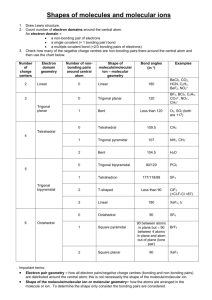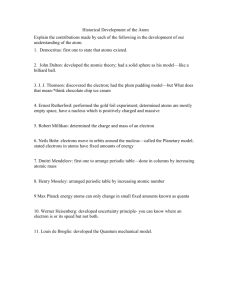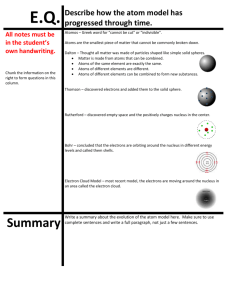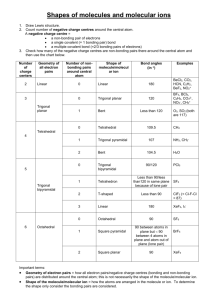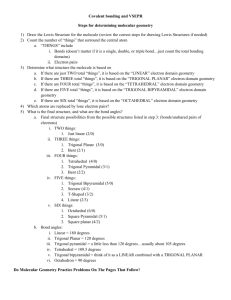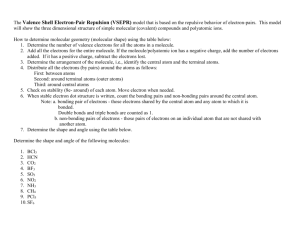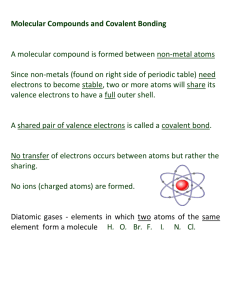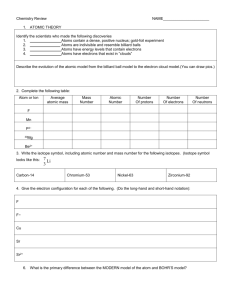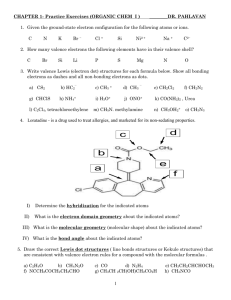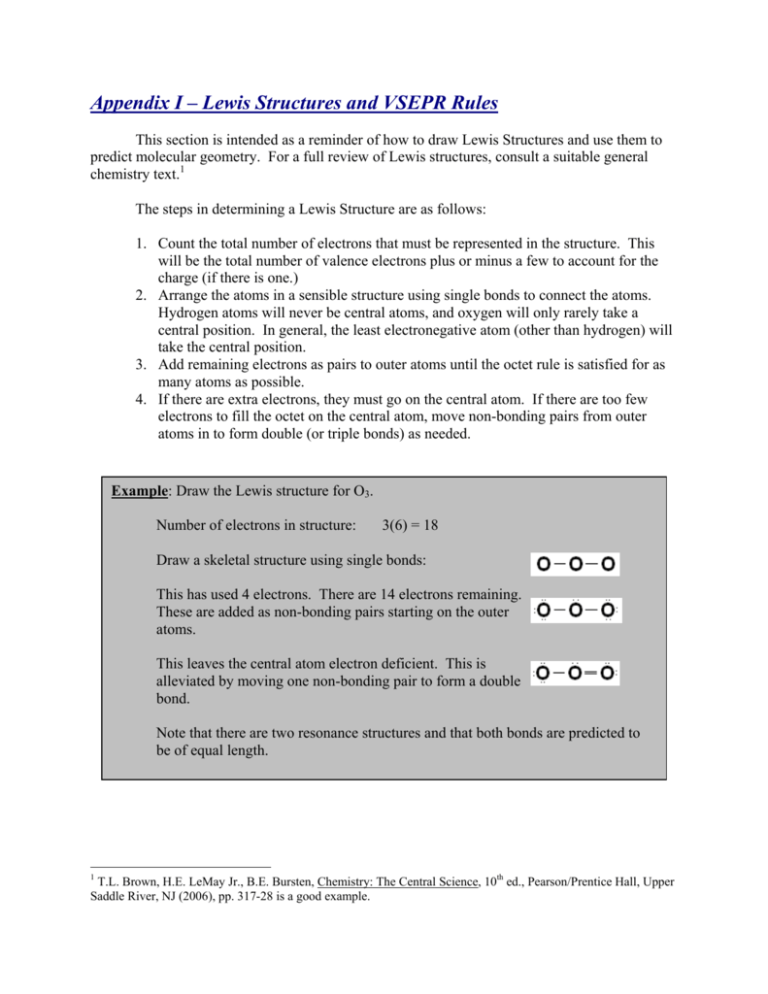
Appendix I – Lewis Structures and VSEPR Rules
This section is intended as a reminder of how to draw Lewis Structures and use them to
predict molecular geometry. For a full review of Lewis structures, consult a suitable general
chemistry text.1
The steps in determining a Lewis Structure are as follows:
1. Count the total number of electrons that must be represented in the structure. This
will be the total number of valence electrons plus or minus a few to account for the
charge (if there is one.)
2. Arrange the atoms in a sensible structure using single bonds to connect the atoms.
Hydrogen atoms will never be central atoms, and oxygen will only rarely take a
central position. In general, the least electronegative atom (other than hydrogen) will
take the central position.
3. Add remaining electrons as pairs to outer atoms until the octet rule is satisfied for as
many atoms as possible.
4. If there are extra electrons, they must go on the central atom. If there are too few
electrons to fill the octet on the central atom, move non-bonding pairs from outer
atoms in to form double (or triple bonds) as needed.
Example: Draw the Lewis structure for O3.
Number of electrons in structure:
3(6) = 18
Draw a skeletal structure using single bonds:
This has used 4 electrons. There are 14 electrons remaining.
These are added as non-bonding pairs starting on the outer
atoms.
This leaves the central atom electron deficient. This is
alleviated by moving one non-bonding pair to form a double
bond.
Note that there are two resonance structures and that both bonds are predicted to
be of equal length.
1
T.L. Brown, H.E. LeMay Jr., B.E. Bursten, Chemistry: The Central Science, 10th ed., Pearson/Prentice Hall, Upper
Saddle River, NJ (2006), pp. 317-28 is a good example.
Example: Draw a Lewis structure for CO3-2
Number of Electrons:
C:
4
4
O:
3(6)
18
Charge: 2
2
---------------------------total
24
Skeletal Structure
(this uses 6 of the 24 electrons)
Now add remaining electrons as pairs on outer atoms:
Whoops! We ran out of electrons! We will need to move a pair from
one of the outer atoms to form a double bond or poor old carbon will not have an octet!
This (on the right) is a correct structure for the Carbonate
ion. Note that there are three resonance structures. This
predicts that the three C-O bonds are of equal length, and
somewhat shorter than a normal C-O single bond, but
longer than a C=O double bond.
Exceptions to the Octet Rule
Some atoms can form stable compounds despite not filling the valence shell to the level of the
nearest noble gas. One important example is boron, which makes compounds with
only six electrons in the valence shell of the central boron atom. (This is the Lewis
structure description that is consistent with boron-centered compounds being such
good Lewis acids.)
Another important class of exceptions are molecules with central atoms in the
third period (usually sulfur of phosphorus) which are surrounded by highly
electronegative atoms (especially halogens, but
sometimes oxygen.) These atoms can expand their
valence octet to accommodate extra electrons by
including d-orbitals into the valence shell. Some
examples of these exceptions are PCl5 and SF6.
VSEPR Rules
The structures molecules take can be predicted by Valence Shell Electron Pair Repulsion
(VSEPR) rules. Briefly, this set of rules is based on the idea that electron pairs, whether
involved in bonding or not, will arrange themselves so as to attain the maximum space between
adjacent pairs. Further, non-bonding electron pairs will take positions in the structure that allow
for the maximum space between themselves and neighboring electron pairs. The following table
can be useful.
#
electron hybridization
domains
2
sp
3
sp2
4
sp3
number
electron domain
of non- molecular
example
geometry
bonding geometry
pairs
0
linear
CO2
linear
1
linear
N2
trigonal
trigonal
0
BF3
planar
planar
1
bent
SO2
0
tetrahedral
CH4
trigonal
1
NH3
tetrahedral
pyramidal
2
bent
H2O
3
linear
HF
These are the possibilities for molecules that obey the octet rule (or in the case of some boroncentered molecules, are electron deficient.) For molecules that have an expanded octet, the
following table is useful.
#
electron hybridization
domains
electron domain
geometry
number
of nonbonding
pairs
0
5
sp3d
trigonal
bipyramidal
6
sp3d2
octahedral
1
2
3
0
1
2
molecular
geometry
trigonal
bipyramidal
“see-saw”
“T-shaped”
linear
octahedral
square
pyramidal
square
planar
example
PCl5
SF4
IF3
XeF2
SF6
IF5
XeF4
The geometries of molecules are predicted by allowing the non-bonding pairs to assume
positions in the electron domain geometry that maximize the space available to them.
Consideration of only the locations of atoms generates the named molecular geometry.
Example: Draw the Lewis Structure, and predict the geometry of BrCl3.
Br:
Cl:
Total
1(7)
3(7)
7
21
28
First, count the electrons:
Now draw a skeletal structure, placing Br
as the central atom and using single bonds.
This accounts for 6 electrons. There are 22 remaining.
These are added as non-bonding pairs, starting around
the outside atoms first.
After adding 20 of the 22 remaining electrons, all atoms
have full octets! The only way to add the remaining two
electrons is to place them on the central atom, forcing it to
expand its valence shell to accommodate the extra electrons.
There are five electron domains about the bromine
atom. Hence, the electron geometry is “trigonal
bipyramidal”. The non-bonding pairs of electrons will
occupy positions that maximize the volume available to
them. This means the non-bonding pairs will occupy
equatorial positions (positions about the triangular portion of the structure), as
these have larger angles between adjacent positions! The molecule is predicted to
have a “T-shaped” geometry.
Dipole moments
Using these rules, one can predict the geometries of a large number of different molecules.
Another question that is often of interest is, “Does the molecule have a dipole moment?” Or
alternatively, “Is the molecular polar?” Both questions are asking the same thing. This is a
question of symmetry. A molecule will be polar (have a dipole moment) if the same thing (atom
or non-bonding pair) does not occupy all equivalent positions in the electron domain geometry.
With the exception of the sp3d (trigonal bipyrimidal) structure, all of the
positions in a given electron domain geometry are equivalent. In the case of
the trigonal bipyramidal structure, there are two types of positions – axial
and equatorial. The two axial positions are equivilent to one another and the
three equatorial positions are equivalent to one another. In the following
diagram, the axial positions are labeled with an “A” and the equatorial
positions with an “E”.
Another way to think of this is that positions that are separated by 180o are equivalent; the three
corners of an equilateral triangle are equivalent; and the four corners of an equilateral tetrahedron
are equivalent. Any molecule that does not have equivalent positions occupied by the same
species can have a dipole moment.
In the case of formaldehyde (H2CO), hydrogen atoms occupy two of the corners of the triangle
about the carbon atom. An oxygen atom is located at the third corner. This molecule has a
dipole moment.
Ozone (O3) is an even stranger case. Oxygen atoms occupy two of the corners, while the third
contains a non-bonding pair of electrons. This non-bonding pair causes the molecule to be bent.
The bent structure is what allows the molecule to have a dipole moment!
Consider the following examples:
Molecular Geometry
Is the molecule
polar?
BF3
Trigonal planar
No
BF2Cl
Trigonal planar
Yes
O3
Trigonal planar
Yes
H2CO
Trigonal planar
Yes
CH4
Tetrahedral
No
Trigonal pyramidal
Yes
Bent
Yes
Molecule
NH3
H2O
Structure
Electron Domain
Geometry
Trigonal planar
Tetrahedral
In a number of cases, the structure of a particular isomer may preclude the molecule from having
a dipole moment, even though a different isomer may have one. Notice in the next table the
different isomers of PCl3F2. If the fluorine atoms are both occupying axial positions, there is no
dipole moment. However, if the fluorine atoms are split between an axial and an equatorial
position, there will be a dipole moment. It is important to match the properties to the correct
structure!
Molecular Geometry
Is the molecule
polar?
PCl5
Trigonal bipyramidal
No
PCl3F2
Trigonal bipyramidal
No
PCl3F2
Trigonal bipyramidal
Yes
SF4
“See-saw”
Yes
IF3
“T-shaped”
Yes
I3-
Linear
No
SF6
Octahedral
No
XeF4
Square planar
No
Octahedral
Yes
Octahedral
No
Molecule
Structure
Electron Domain
Geometry
Trigonal bipyramidal
Octahedral
SF4Cl2

